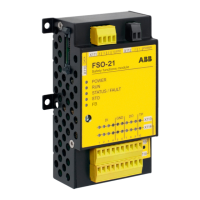486 Verification and validation
Validation of the cascaded safety function
Without a PROFIsafe communication bus, you can cascade only safety functions
which have a primary and a secondary digital input: STO, SS1, SSE, SLS1, SDI
positive and SDI negative. Repeat the cascading validation procedure to all cascaded
safety functions in your application.
This example shows how to validate the SSE function in a cascaded system
(Cascade A) as shown in section Cascade on page 62.
1. Make sure that the cascaded safety function(s) are configured according to the
wiring diagram.
2. Make sure that the cascaded safety functions are configured correctly according
to your design. For a configuration example see chapter How to configure a
cascaded system on page 322. Check these settings:
Master FSO:
• SAFEIO.11 M/F mode for cascade
• SAFEIO.12 Cascade A
• STO.02 STO acknowledgement = automatic
• SSE.11 SSE input A
• SSE.12 SSE input B
• SSE.21 SSE output
• FSOGEN.42 Acknowledgement button input
Follower FSO modules (check the settings in each follower FSO module in the
cascade chain):
• SAFEIO.11 M/F mode for cascade
• STO.02 STO acknowledgement = Automatic
• SSE.11 SSE input A or SSE.12 SSE input B
• SSE.21 SSE output
3. Activate cascaded safety function from the master FSO module.
4. Check that the correct safety function is activated in the whole cascaded chain.
5. Check that all cascaded safety functions are operating correctly according to the
design in each of the cascaded FSO module.
6. Deactivate cascaded safety functions from the master FSO, and acknowledge the
safety function by using manual acknowledgement if in use.
7. Check that the follower FSO modules are acknowledged.
Repeat this procedure for the Cascade B chain if in use.

